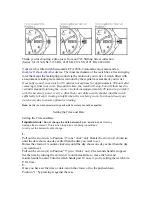
About Training Effect
Training Effect measures the impact of an activity on your aerobic and anaerobic fitness. Training Effect
accumulates during the activity. As the activity progresses, the Training Effect value increases. Training Effect
is determined by your user profile information and training history, and heart rate, duration, and intensity of your
activity. There are seven different Training Effect labels to describe the primary benefit of your activity. Each
label is color coded and corresponds to your training load focus (
). Each
feedback phrase, for example, "Highly Impacting VO2 Max." has a corresponding description in your Garmin
Connect activity details.
Aerobic Training Effect uses your heart rate to measure how the accumulated intensity of an exercise affects
your aerobic fitness and indicates if the workout had a maintaining or improving effect on your fitness level.
Your excess post-exercise oxygen consumption (EPOC) accumulated during exercise is mapped to a range of
values that account for your fitness level and training habits. Steady workouts at moderate effort or workouts
involving longer intervals (>180 sec) have a positive impact on your aerobic metabolism and result in an
improved aerobic Training Effect.
Anaerobic Training Effect uses heart rate and speed (or power) to determine how a workout affects your ability
to perform at very high intensity. You receive a value based on the anaerobic contribution to EPOC and the type
of activity. Repeated high-intensity intervals of 10 to 120 seconds have a highly beneficial impact on your
anaerobic capability and result in an improved anaerobic Training Effect.
You can add Aerobic Training Effect and Anaerobic Training Effect as data fields to one of your training screens
to monitor your numbers throughout the activity.
Training Effect Aerobic Benefit
Anaerobic Benefit
From 0.0 to 0.9 No benefit.
No benefit.
From 1.0 to 1.9 Minor benefit.
Minor benefit.
From 2.0 to 2.9 Maintains your aerobic fitness.
Maintains your anaerobic fitness.
From 3.0 to 3.9 Impacts your aerobic fitness.
Impacts your anaerobic fitness.
From 4.0 to 4.9 Highly impacts your aerobic fitness.
Highly impacts your anaerobic fitness.
5.0
Overreaching and potentially harmful without
enough recovery time.
Overreaching and potentially harmful without
enough recovery time.
Training Effect technology is provided and supported by Firstbeat Technologies Ltd. For more information, go to
Heart Rate Variability and Stress Level
Stress level is the result of a three-minute test performed while standing still, where the Descent device
analyzes heart rate variability to determine your overall stress. Training, sleep, nutrition, and general life stress
all impact how a runner performs. The stress level range is from 1 to 100, where 1 is a very low stress state and
100 is a very high stress state. Knowing your stress level can help you decide if your body is ready for a tough
training run or yoga.
Viewing Your Heart Rate Variability and Stress Level
This feature requires a Garmin chest heart rate monitor. Before you can view your heart rate variability (HRV)
stress level, you must put on a heart rate monitor and pair it with your device (
Pairing Your Wireless Sensors,
).
TIP: Garmin recommends that you measure your stress level at approximately the same time and under the
same conditions every day.
1 If necessary, press START, and select Add > HRV Stress to add the stress app to the apps list.
2 Select Yes to add the app to your list of favorites.
3 From the watch face, press START, select HRV Stress, and press START.
4 Stand still, and rest for 3 minutes.
62
Heart Rate Features
















































